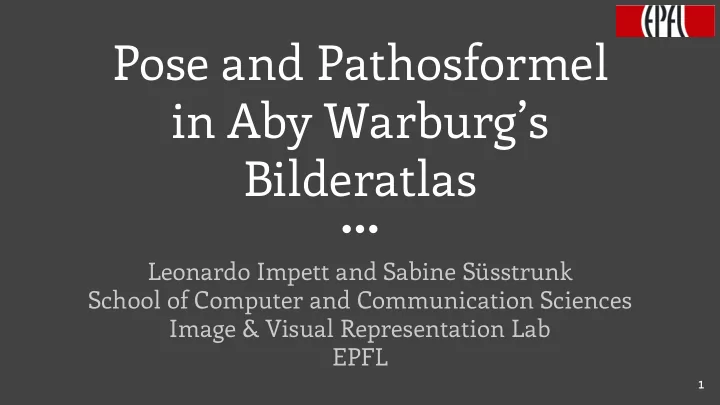

Pose and Pathosformel in Aby Warburg’s Bilderatlas Leonardo Impett and Sabine Süsstrunk School of Computer and Communication Sciences Image & Visual Representation Lab EPFL 1
I - Digital Art History 2
Aby Warburg 1866-1929 ● Worked on Bilderatlas from ● 1926 Kulturwissenschaftliche ● Bibliothek Warburg Memory of the Classical in ● the Western world Image: Kunstkritic.no 3
Pathos formel 4
A repeatable formula Pathos formel The expression of pathos; pathetic emotions; passion 5
Detail of vase from Nola. Paris, Louvre 6
After vase from Chiusi, from Annali , 1871 7
Woodcut from Ovid, Metamorphoses , Venice 1497 8
Northern Italian engraving, 1470-90, School of Mantegna Hamburg, Kunsthalle 9
Albrecht Dürer, Death of Orpheus , 1494 Hamburg, Kunsthalle 10
11
Nachleben der Antike The afterlife of classical antiquity - resurgence and persistance “In a number of ways, the Death of Orpheus serves to clarify this emotive, rhetorical current within the reawakening of antiquity… [this method] lays bare certain phenomena, hitherto unnoticed, that cast a more general light on the circulation and exchange of expressive forms in art” 12
Aby Warburg’s Bilderatlas 10 3 -10 4 bodies? 1230 paintings 63 panels 13
II - Operationalisating the Pathosformel 14
Pathos? Phobic impressions - Expressive values - Interior emotion - Passionate experience - Pagan exaltation - Orgiastic experience - Boundless unleashing - Expressive manifestations - Phobias - Interior abandon - Murderous drunkenness - Paroxystic fervour - Nouvelle gestuelle pathetique 15
Operationalisation The conversion of pathos into pose . Operationalisation forces us: Remain conscious of what we lose - movement of hair, wind, limbs, hands ● Look more closely but also more critically at the concept itself ● First digital encoding of pose in an art database: Da Silva, Nuno Pinho, et al. "Explaining scene composition using kinematic chains of humans: application to Portuguese tiles history." Computer Vision and Image Analysis of Art II , SPIE, 2011. 16
Collecting a Dataset Bilderatlas is of art-historical interest but also an excellent training set for ● computer-vision (stylistically heterogeneous) The scale of the problem: ● 10 3 -10 4 bodies in 1,200 images (and annotate each body thrice!) ○ Which bodies to annotate? ● Crowdsourcing annotations ● 17
Aby Warburg’s Bilderatlas 10 3 -10 4 bodies? 1230 paintings 63 panels 18
Aby Warburg’s Bilderatlas 10 3 -10 4 bodies? 1230 paintings 63 panels 1,665 bodies 313 paintings 21 panels 19
20
III - Analysis 21
Normalising body poses Normalise lengths of Flip, rotate limbs Right hand Convert higher, vectors spine (limbs) to vertical angles 11-D angles 24-D (x,y)-coordinates 22
Two-stage Clustering Morphological similarity is meaningless over large differences (but useful over small ones). Two-stage clustering: 1. Rotational K-means: 1,665 poses into K stable clusters 2. Rotational Hierarchical Clustering: phylogenetic tree of the morphological structure within each cluster 23
24
25
Identifying Pathosformeln Pathosformeln identified in the literature: Nymph / Perseus / Proserpina / Orpheus / Menead / Fortuna / Laocoön 26
27
28
29
30
Identifying Pathosformeln Pathosformeln identified in the literature: Nymph / Perseus / Pentheus / Proserpina / Orpheus / Menead / Fortuna / Laocoön Clustered almost exclusively together. Strong morphological similarity between different formulae for the representation of (different) emotions. 31
Nachleben der Antike The Rebirth of Classical Antiquity : different clusters have different classical membership (20-50%). Our strongest (preliminary) results: the exiled Nymph has (almost) no antique presence . 32
Conclusions Our operationalisation gives us surprising results even with a small dataset: Evidence to support the existence of Pathsoformeln and their renewal from ● antiquity. Pathosformeln can be characterised by body-pose: they’re all similar in ● pose-space The figure of the Nymph has no classical referent in the Bilderatlas ● Limitations on the reduction itself; the principle of Antithesis , and motion. ● 33
Current and Future Work Full annotation of the Bilderatlas to take place in the next ~6 months ● (public data release). Large-scale pose dataset for computer-vision in paintings. From ‘% Antique’ to Nachleben ● 3D pose estimation and encoding - bodies in motion ● Automatic recognition of pose in paintings ● Automatic identification of Pathosformeln ● 34
Questions Leonardo Impett, Sabine Süsstrunk leonardo.impett@epfl.ch ivrl.epfl.ch With thanks to: Franco Moretti, EPFL José Emilio Burucùa, Nantes Institute for Advanced Study John Robb & Robin Osborne, University of Cambridge Isabella di Lenardo, EPFL 35
Two-stage annotation 2: Annotate poses 1: Separate bodies 36
10 Samples (Gaussian) Ideal-type Insignificant Significant 37
Two-stage Clustering 38
Recommend
More recommend